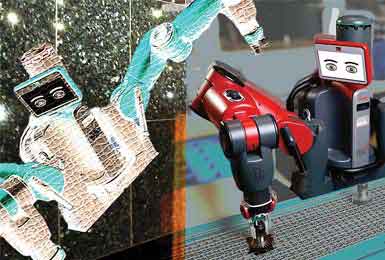Robotics: Changing Manufacturing Processes...and Facility Requirements
Today’s robotics are having an impact on the factory floor, in warehouse and distribution centers, and even in executive offices and homes.
Directory 2013

Used by Companies Large and Small
“In the past, only large companies with numerous repetitive tasks, such as automotive manufacturers, could afford robotics. Today, efficient, cost-effective robots are available for both mid-sized and small companies for low-volume projects or parts,” says Justin Percio business manager for the automated welding segment of Lincoln Electric in Cleveland, Ohio.
“Our robotic welding cells serve a wide variety of industries — from offshore drilling to wind power and from shipbuilding to heavy fabrication. Companies looking for ways to increase output and achieve quality improvement at the same time are turning to robotic welding systems,” Percio points out. “In the past, automotive companies and other large manufacturers used robotics to do one thing or insert one part millions of times over the years. Today, robots are flexible enough to work on a large variety of parts or tasks cost-effectively. You can cut cycle time 20 percent to 60 percent depending on the complexity of the part,” he adds.
Expanded Use in the Manufacturing Process
Cotterman Company — a Croswell, Michigan, manufacturer of various industrial ladders, work platforms, and lift platforms — teamed up with Lincoln Electric and AccuBilt of Jackson, Michigan, to introduce robotics into its manufacturing process.
“Our challenge was to increase our flexibility and reduce manufacturing turnaround time in order to fulfill orders in a matter of days,” stressed Nick Valore, Cotterman’s vice president. “We wanted to reduce finish goods inventories and make small batches for immediate delivery. We have four manufacturing plants across the country [that allow us to] supply our customers with the product they want, when they want it. This also helps reduces freight costs, inventory costs, and freight damage and delays.”
Cotterman’s ladders and platforms use a wide variety of parts combinations depending on the customer’s requirements. The flexible tooling of the robotic welding system is capable of identifying the ladder configuration and the parts required to build each specific ladder. The system can handle thousands of different parts combinations. In turn, increased productivity helps Cotterman deliver a first-class product at a competitive price.
Valore also points out, “While our biggest competitor buys from China and has to maintain inventory, we build a quality product to order and get it to the customer quickly. Robotics help us achieve this strategy. Conventional wisdom states robotics are used to replace workers. In our case, we have actually increased our work force since we started using robotics as a tool to increase productivity, improve quality, and cut costs. The increased use of robotics played a role in the 24,000-square-foot expansion of our Michigan manufacturing plant.”
Next: Robotics in Logistics/Distribution Settings and its Impact on Facility Layouts
Project Announcements
Apex Plastics Opens Expanded Production Plant In Brookfield, Missouri
09/22/2014
Japan-Based Bridgestone Rubber-BSA Opens Biorubber Process Research Center In Mesa, Arizona
09/22/2014
SpencerARL Expands Its Plattsburgh, New York, Manufacturing Facility
09/22/2014
Hill International, Inc. Relocates Corporate Headquarters To Philadelphia, Pennsylvania
09/22/2014
Prysmian Group Plans $8.2 Million Expansion At Abbeville County, South Carolina, Manufacturing Center
09/22/2014
Japan-Based Kowa Kentucky Plans $8.3 Million Manufacturing Facility In Corbin, Kentucky
09/22/2014
Most Read
-
The Workforce Bottleneck in America’s Manufacturing Revival
Q4 2025
-
Rethinking Local Governments Through Consolidation and Choice
Q3 2025
-
First Person: Filter King’s Expansion Playbook
Q3 2025
-
Lead with Facts, Land the Deal
Q3 2025
-
How Canada Stays Competitive
Q3 2025
-
Investors Seek Shelter in Food-Focused Real Estate
Q3 2025
-
America’s Aerospace Reboot
Q3 2025
